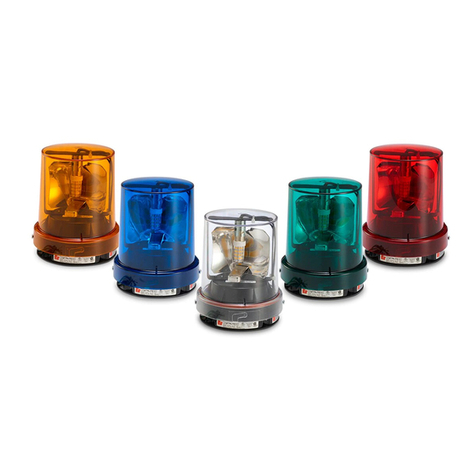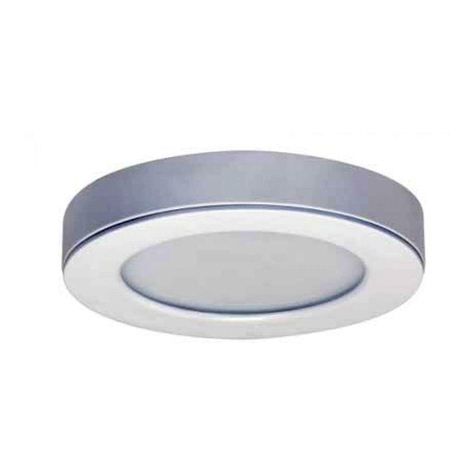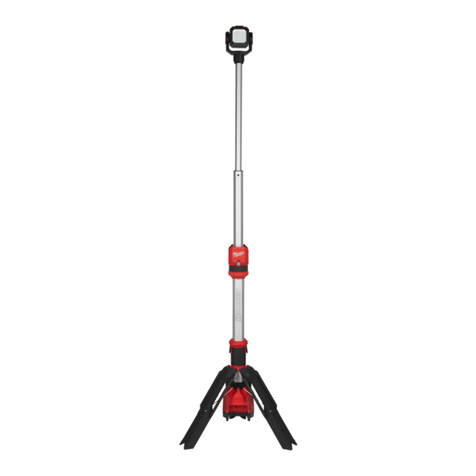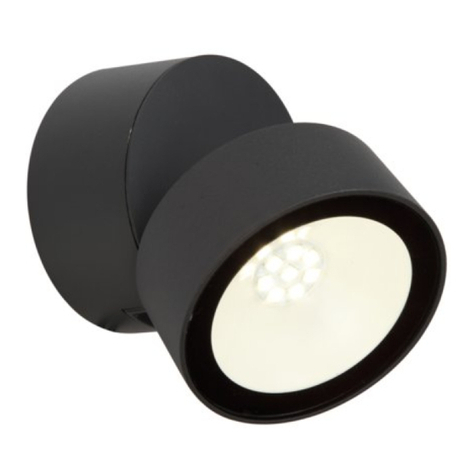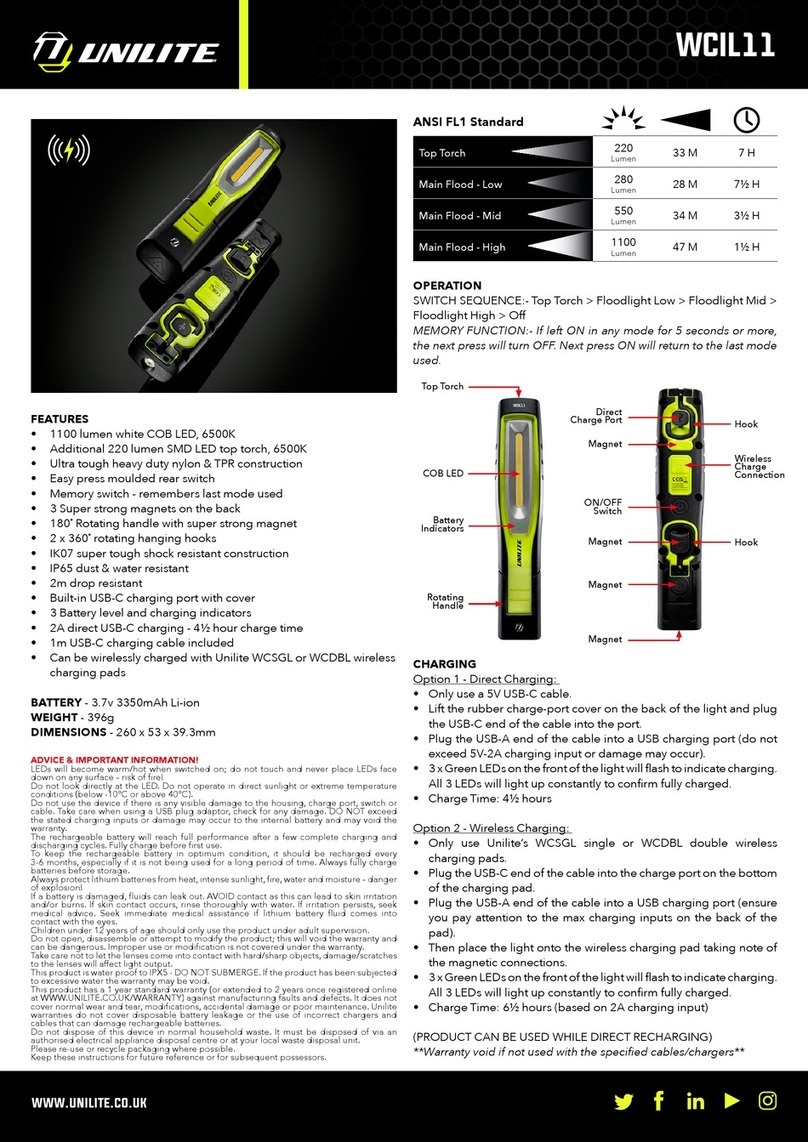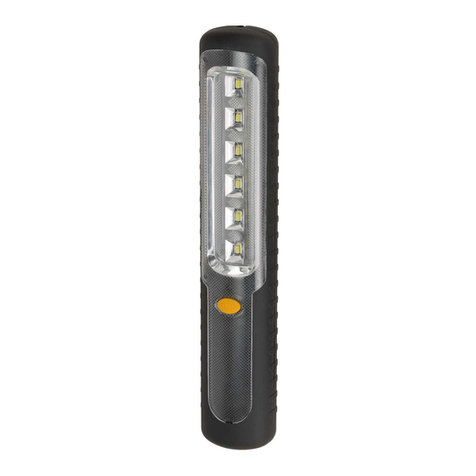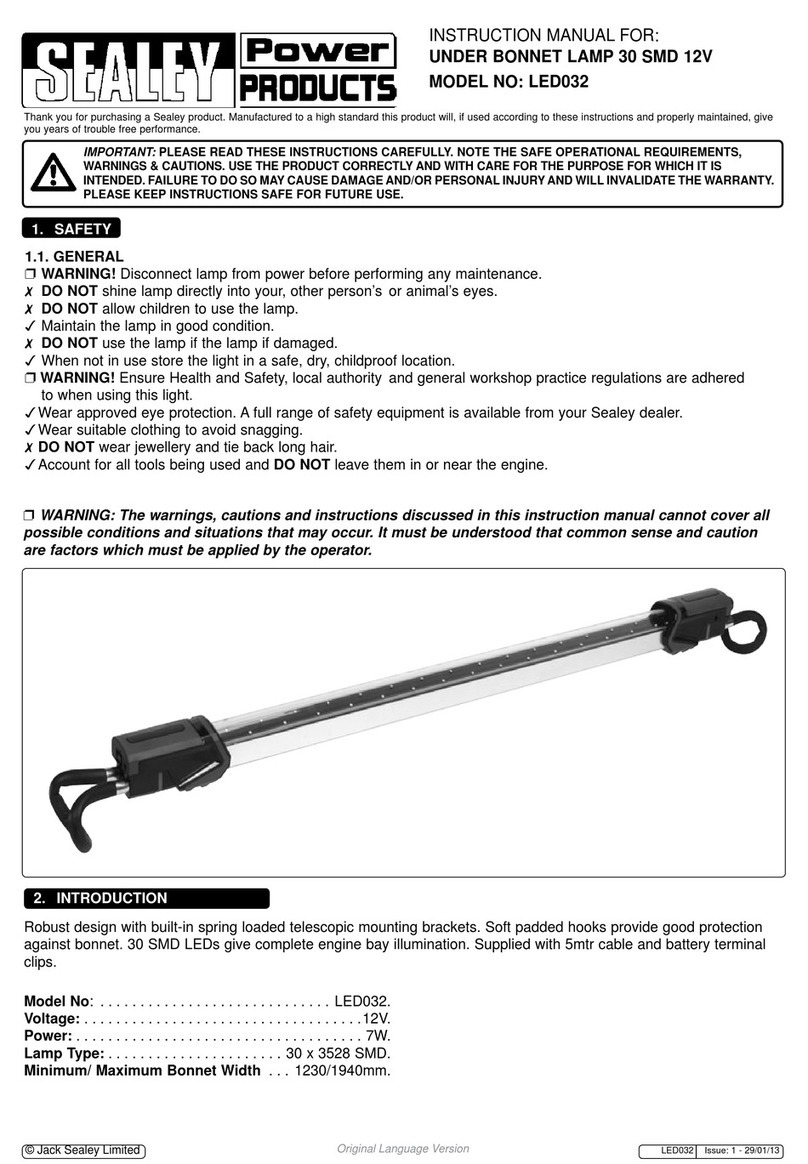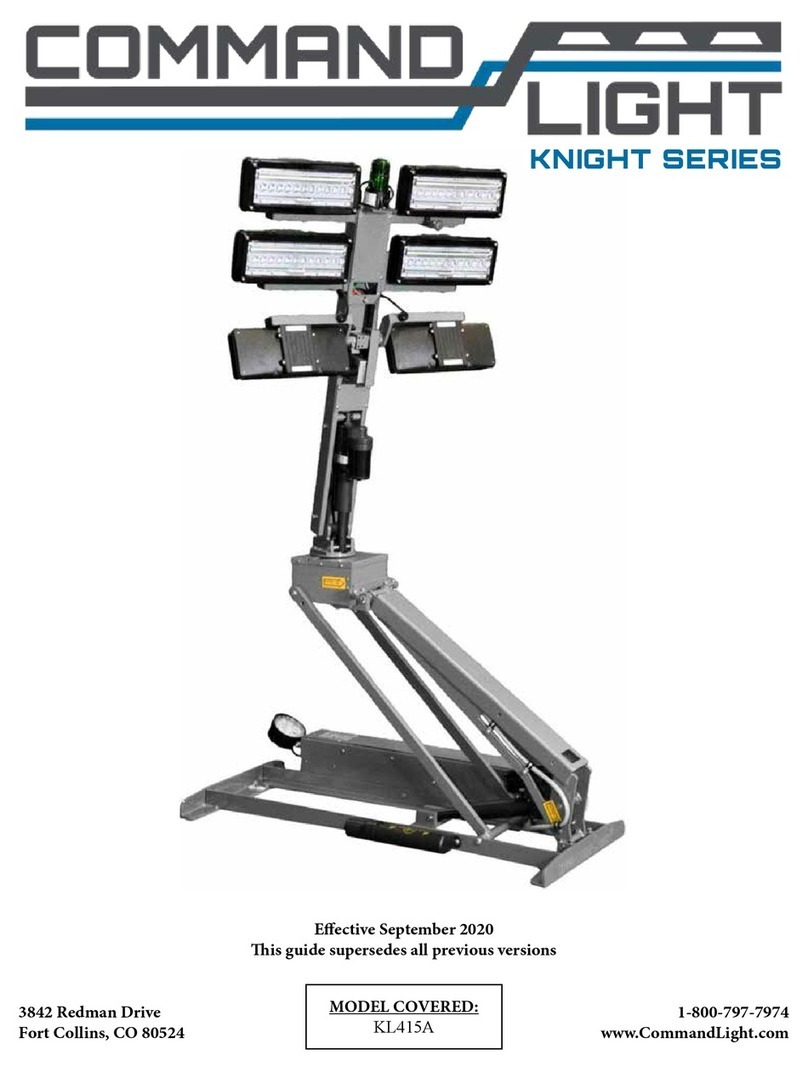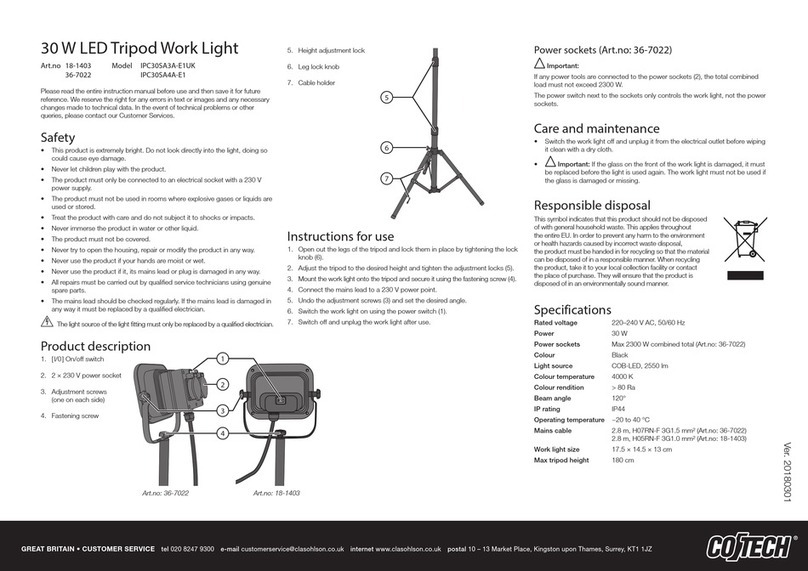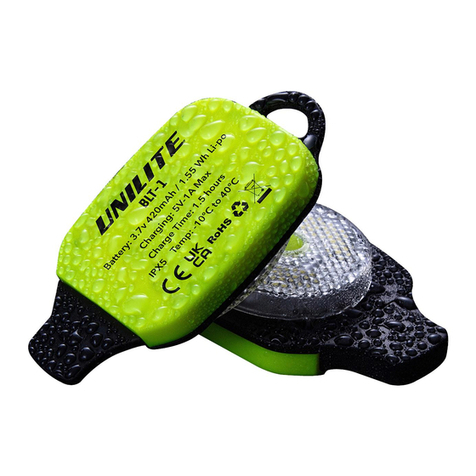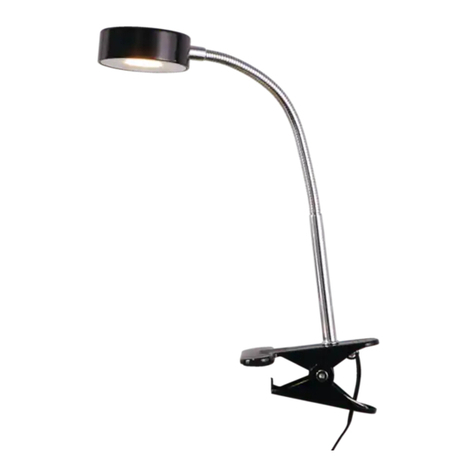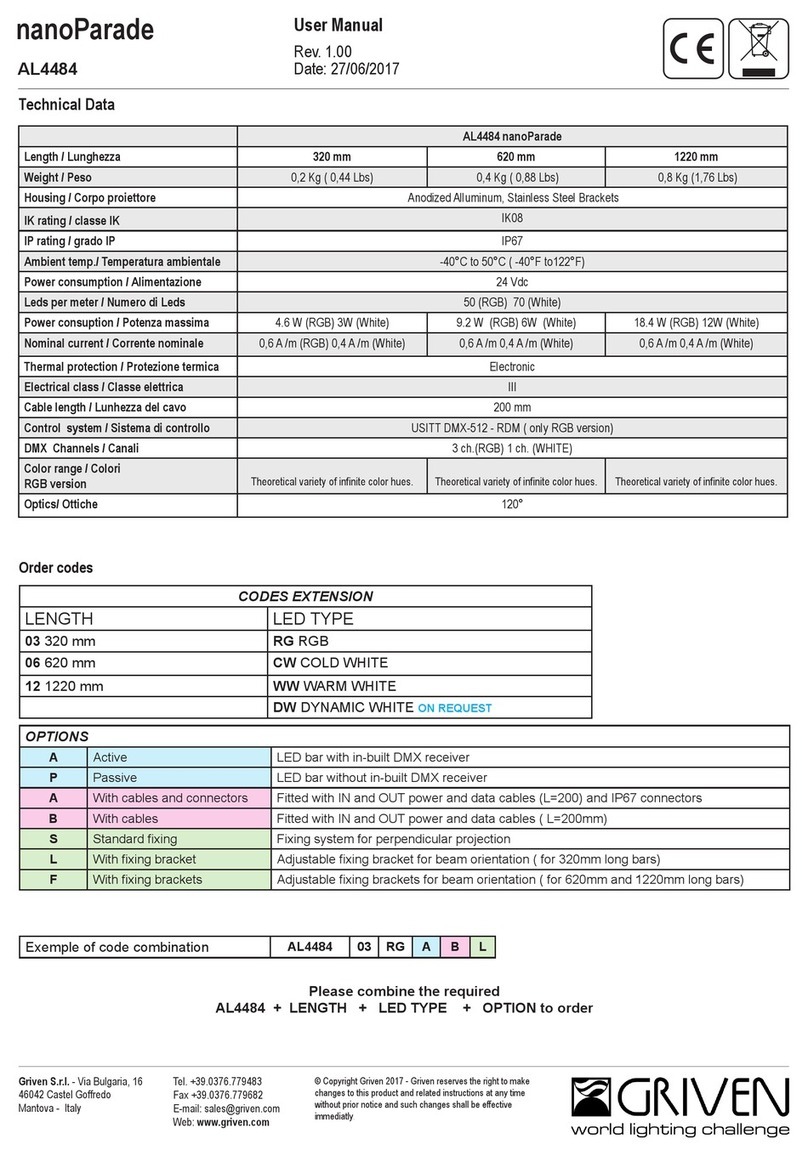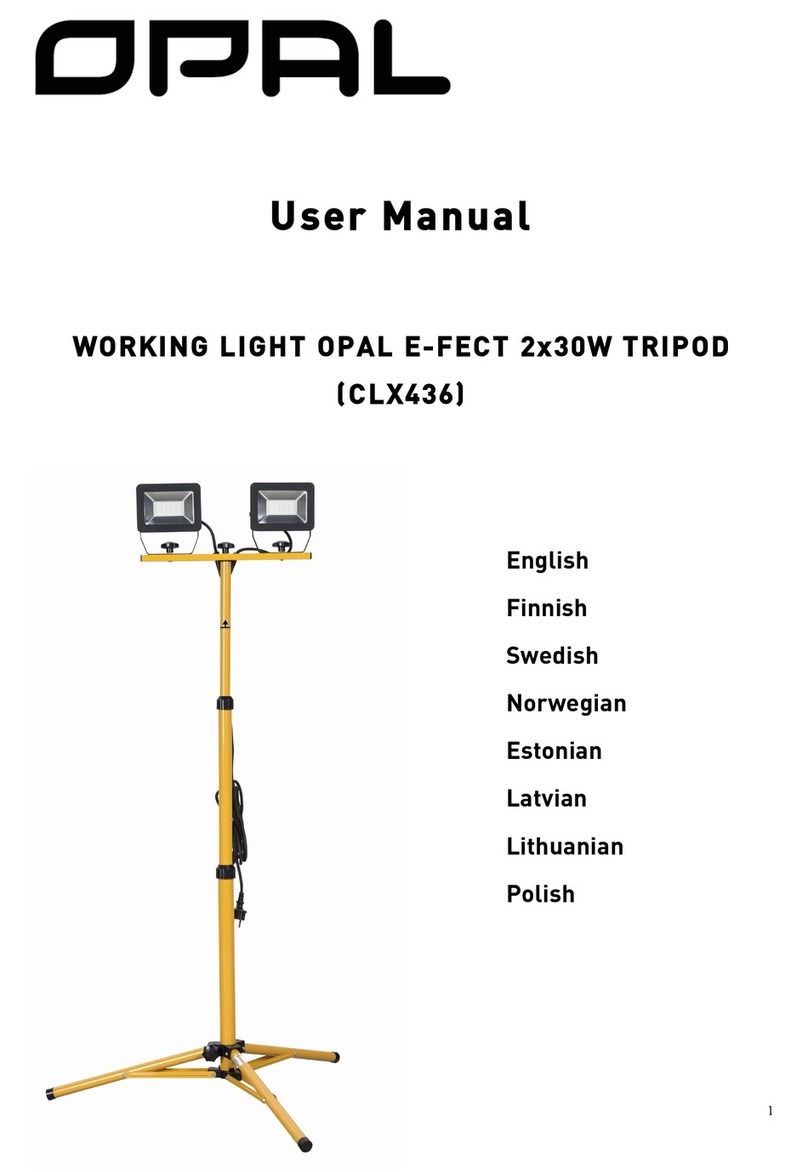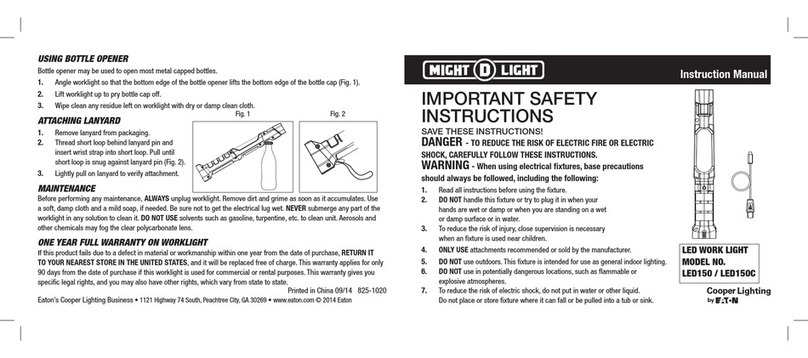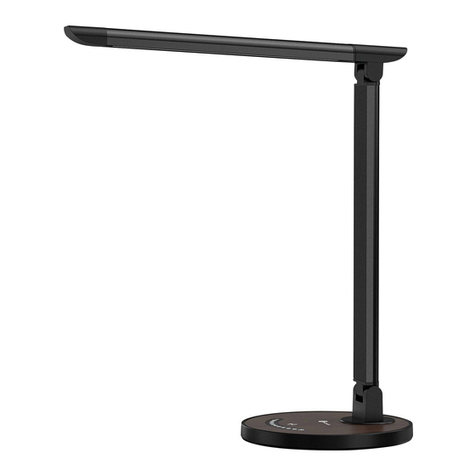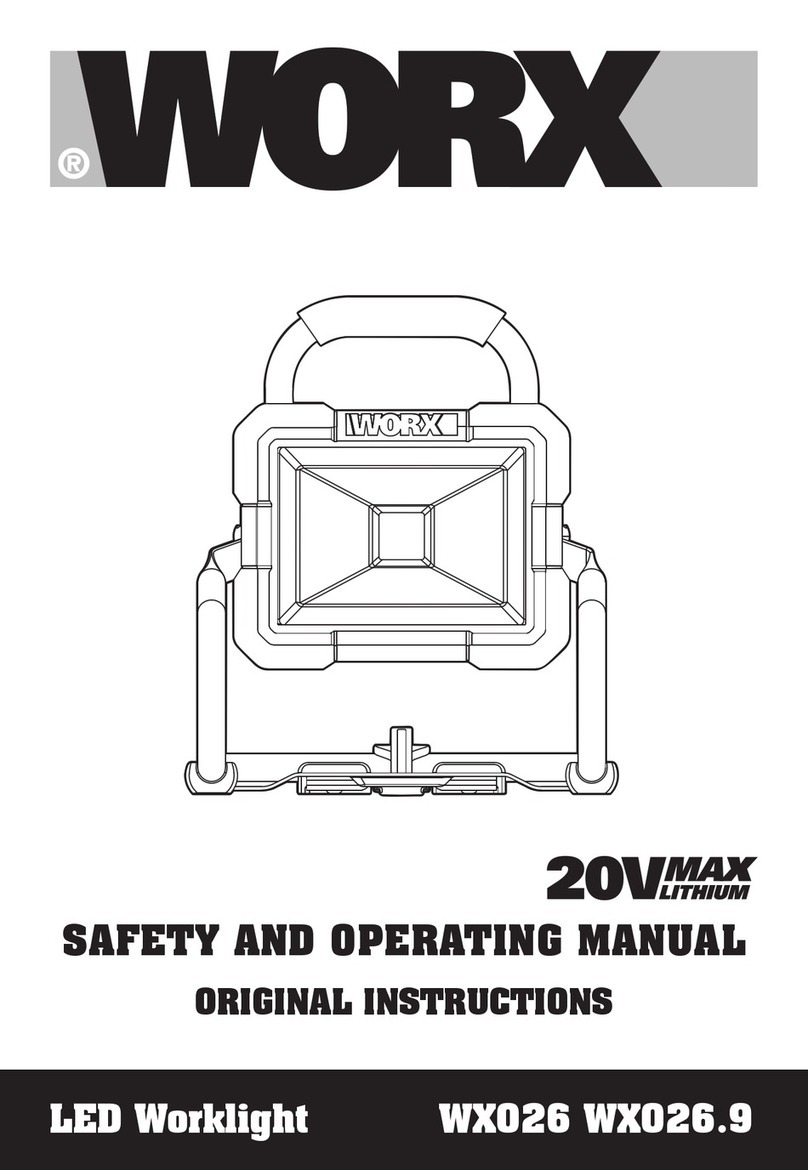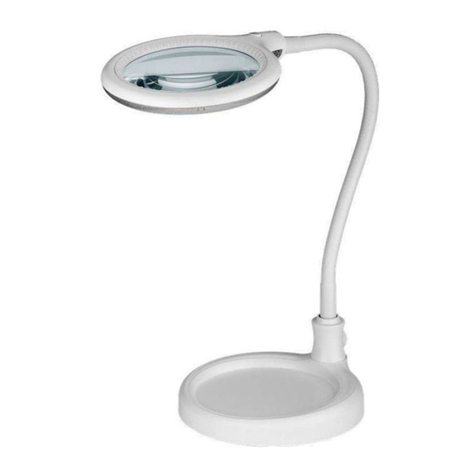Federal Signal Corporation RAYDIAN User manual

2562227B
REV. B 1006
Printed in U.S.A
INSTALLATION AND MAINTENANCE INSTRUCTIONS FOR
HEAVY-DUTY RAYDIAN® LED LIGHTBAR
SAFETY MESSAGE TO INSTALLERS AND USERS
People’s lives depend on your safe installa-
tion of our products. It is important to read,
under- stand, and follow all instructions
shipped with the products. In addition, listed
below are some other important safety in-
structions and precautions you should follow:
• To properly install lightbar, you must
have a good understanding of automo-
tive systems, along with proficiency in
the installation and use of safety warning
equipment.
• DO NOT install equipment or route wir-
ing in the deployment path of an air bag.
• This product contains high intensity LED
devices. To prevent permanent eye dam-
age, DO NOT stare into the light beam at
close range.
• A light system is a high current device. In
order for it to function properly, a sepa-
rate ground connection must be made. If
practical, it should be connected to the
negative battery terminal. At a minimum,
it may be attached to a solid metal body
or chassis part that will provide an effec-
tive ground path as long as the light sys-
tem is used.
• When drilling into a vehicle structure, be
sure both side of the surface are clear of
anything that could be damaged.
• Locate the light system controls so the
VEHICLE and CONTROLS can be oper-
ated safely under all driving conditions.
• The mounting system should be periodi-
cally inspected to ensure that it is secure-
ly attached to the vehicle.
• File these instructions in a safe place and
refer to them when maintaining and/or
reinstalling the product.
Failure to follow all safety precautions and
instructions may result in property damage, serious
injury, or death to you or others.
I. GENERAL.
HEAVY OBJECT
Get assistance when lifting or installing.
Failure to do so will cause permanent bodily
injury.
The Raydian is a LED light bar, with supplemental
white halogen area lighting, designed for use with Federal
Signal lightbar controllers and/or single switches rated
at 2-amperes and above. The base is a two piece extruded
aluminum profile with polycarbonate lenses and end
domes. The unit is supplied with mounting hardware and
a thirty-foot cable, and has an operating temperature of
–40oC to +65oC.
II. UNPACKING.
After unpacking the Raydian light assembly, inspect it
for damage that may have occurred in transit. If the unit
has been damaged, do not attempt to install or operate
it. File a claim immediately with the carrier, stating
the extent of the damage. Carefully check all envelopes,
shipping labels, and tags before removing or destroying
them.
III. INSTALLATION.
A. General.
Before proceeding, ensure that the lightbar has
been installed on the vehicle roof in accordance with the
instructions packed with the mounting kit. The lightbar is
completely wired at the factory and does not require any
additional internal wiring. All the conductors necessary
for control of any and all basic and optional functions are
contained in the cables. The basic light functions of the unit
must be controlled by a user-supplied control head.
Light system controls must be located so the
VEHICLE and CONTROLS can be operated
safely under all driving conditions.
1. Route the control cable into the vehicle and
near the eventual location of the user-supplied control
head. Route the Red 10 gauge power wire into the vehicle
and to the battery.
2. For proper light operation, the control cable
must be properly terminated inside the user-supplied
control head. Using figure 1 as a guide, make the

Figure 1.
appropriate electrical connections. Ensure that the lines
are adequately fused as shown and that the switch capacity
is adequate for the current requirement.
Reverse polarity may damage any power supply
and prevent operation. Ensure that the correct po-
larity is observed. The positive (+) power lead must
be fused at the source for 40 amps.
3. Connect the separate 10 gauge black lead to
the vehicle ground terminal (-) and separate 10 gauge red
lead to the vehicle battery hot terminal (+).
NOTE
All the lightbar functions can be activated by
applying 12VDC to the appropriate control line.
The 10 gauge black and red power leads must be
connected to their respective battery terminals for
a function check.
B. Function Activation – Excluding SignalMaster™
(see figure1).
1. Mode Inputs.
There are three modes of operation available.
Mode 1 (RED), Mode 2 (ORANGE), and Mode 3 (YELLOW)
each have ten unique programmable flash patterns. One
of the ten available flash patterns can be programmed to
each mode input. Programming will be covered later in this
section. To activate a mode, apply 12VDC to a mode input
wire.
2. Front-light Cut Off.
Applying 12VDC to the front-light cut off
(GREEN) wire will cause the front of the lightbar to cut off.
When the front-light cut off is active, only the rear and rear
portion of the end cap will function.
3. Rear-light Cut Off.
Applying 12VDC to the rear-light cut off
(GREY) wire will cause the rear of the lightbar to cut off.
When the rear-light cut off is active, only the front and
front portion of the end cap will function.
4. Work Lights.
Applying 12VDC to the Work lights (BROWN)
wire will cause the Work lights to illuminate.
5. Right Alley.
Applying 12VDC to the Right Alley (BLUE)
wire will cause the Right Alley lights to illuminate.
6. Left Alley.
Applying 12VDC to the Left Alley (VIOLET)
wire will cause the Left Alley lights to illuminate.
7. Mode Programming.
Each of the modes of operation can be
programmed to operate with one of the available flash
patterns listed below (see figure 2).
Mode 1 (Stand By Mode)
1 - Alternate Single Flash D1, D2, & S1 with P1, P2, &
S8
2 - Alternate Single Flash S1, S2 with S7, S8
3 - Alternate Double Flash S1, S2, S7, S8 with S3, S4,
S5, S6
4 - Alternate Double Flash S1, S2, S7, S8 with S3, S4,
S5, S6, P1, P2, D1, D2
5 - Alternate Double Flash S1, S2, S7, S8 with S3, S4,
S5, S6
6 - Alternate Double Flash D1, D2, P1, P2 with S3, S4,
S5, S6
7 - Alternate Double Flash D1, D2, P1, P2 with S3, S4,
S5, S6 followed by Alternate Double Flash S1, S2,
S7, S8 with S3, S4, S5, S6, P1, P2, D1, D2
8 – Wrap-Around Inside to Outside
9 – Wrap-Around Inside to Outside to Inside followed
by Wig/Wag Alternate Flash
10 -Alternate Full Flash - S1, S3, S6, S8, D2, D4, D5,
D6, D7, D8, P2, P4, P5, P6, P7, P8 with S2, S4, S5,
S7, D1, D3, P1, P3
-2-
Figure 2.
290A5632
RED
1 A
1 A
1 A
1 A
1 A
1 A
1 A
1 A
1 A
1 A
MODE 1
ORANGE MODE 2
YELLOW MODE 3
GREEN FRONT LIGHT CUT-OFF
GREY REAR LIGHT CUT-OFF
BROWN WORKLIGHTS
VIOLET LEFT ALLEY
BLUE RIGHT ALLEY
BEIGE SIGNALMASTER RIGHT
WHITE SIGNALMASTER LEFT
1 A
1 A BLACK SIGNALMASTER CENTER-OUT
PINK PROGRAM
RED LOW POWER
GREEN PASSENGER-SIDE HIGH POWER
WHITE DRIVER-SIDE HIGH POWER
BLACK GROUND
(+) BATTERY
(-) BATTERY
CONTROL CABLE
(+) POWER/IGN
(+) BATTERY
(-) BATTERY
12 COND 22 AWG CABLE
4 COND 18 AWG CABLE
40 A
STOP/TAIL/TURN CABLE
S/T/T S/T/T
WK
LGT
WK
LGT
D1
D2
D3 D4 D5 D6
P1
P2
P3
P4
P5
P6
S2S1 S3 S4 S6 S7 S8
QUADRANT A QUADRANT B QUADRANT C QUADRANT D
290A5633

Mode 2 (Tow Mode)
1 - Alternate Double Flash D1, D4, D6, D8, P1, P4, P6,
P8 with D2, D3, D5, D7, P2, P3, P5, P7 with A
Center Out SignalMaster.
2 - Alternate Double Flash D1, D4, D6, D8, P1, P4, P6,
P8 with a Single Flash Of D2, D3, D5, D7, P2,
P3, P5, P7 with A Signalmaster Pattern Of S1, S2,
S7, S8 Alternating with S3, S4, S5, S6.
3 - The Lightbar is split into 4 Quadrants: A, B, C, &
D and are flashed as follows: A, C, B, D, A, C, B,
D…...Each block is Single Flashed at 50ms per
Flash.
4 - Double Quadrant Flash, followed by a full lightbar
Quad Flash, followed by a single Quadrant Flash.
5 - Quad Flash – Wrap-Around Inside to Outside
– Followed by a full lightbar Quad Flash.
6 – Wrap-Around Inside to Outside – 30ms Per Head.
7 - Alternate Full Flash followed by Tow Mode Pattern
2.
8 - Quad Flash – Alternate Quad Flash Each side of
bar.
9 – Wrap-Around Inside to Outside to Inside followed
by a Wig/Wag Alternate Flash followed by a Full
Quad Flash.
10 –Wrap-Around Inside to Outside followed by a Quad
Flash.
Mode 3 (On Scene Mode)
1 - Alternate Double Flash outside pairs with Quad
Flash inside pairs and End Caps.
2 - Quadrant Flash, followed by a Wrap-Around Inside
to Outside, followed by a full lightbar Triple Flash.
3 - Increasing Rate Alternating Flash, followed by a
full lightbar Triple Flash.
4 - Alternate Triple Flash entire bar.
5 – Alternate Double Flash S1, S2, S3, S4, D1, D4, D6,
D8, P1, P4, P6, P8 with S5, S6, S7, S8, D2, D3, D5,
D7, P2, P3, P5, P7.
6 – Alternate Double Flash S1, S3, S5, S7, D1, D4, D6,
D8, P1, P4, P6, P8 with S2, S4, S6, S8, D2, D3, D5,
D7, P2, P3, P5, P7, followed by a Wrap-Around
Inside to Outside.
7 – Double Flash S1, S3, S5, S7, D1, D4, D6, D8, P1,
P4, P6, P8, followed by a Wrap-Around Inside to
Outside, followed by a Double Flash of S2, S4, S6,
S8, D2, D3, D5, D7, P2, P3, P5, P7, followed by a
Wrap-Around Outside to Inside.
8 – Wrap-Around Inside to Outside, followed by an
Alternate Double Flash, followed by a Wrap-
Around Inside to Outside, followed by a full
lightbar Double Flash.
9 - Full Lightbar Quad Flash, followed by a Wrap-
Around Inside to Outside, followed by an Alternate
Double Flash, followed by a Wrap-Around Inside to
Outside.
10 –Alternate Triple Flash entire bar twice, followed
by a Wrap-Around Inside to Outside, followed by
an Alternate Double Flash, followed by a Wrap-
Around Inside to Outside.
Programming is accomplished as follows:
a. Apply 12VDC to the mode input to be
programmed. The bar will flash the current pattern.
b. Momentarily apply 12VDC to the
Program (PINK) wire. The lightbar will stop briefly, then
the entire lightbar LEDs will flash the number of the new
flash pattern. The lightbar will then begin to flash the
newly selected pattern.
c. Repeat step b until the desired pattern is
selected.
d. To program the other modes, apply
12VDC to the desire mode input and repeat steps b and c.
C. Function Activiation – SignalMaster.
1. SignalMaster Center-Out (Warn)
Applying 12VDC to the SignalMaster Center-
out (BLACK) wire will cause the SignalMaster lights to
illuminate from the Center-out.
2. SignalMaster Left to Right
Applying 12VDC to the SignalMaster Right
(BIEGE) wire will cause the SignalMaster lights to
illuminate from the Left to the Right.
3. SignalMaster Right to Left
Applying 12VDC to the SignalMaster Left
(WHITE) wire will cause the SignalMaster lights to
illuminate from the Right to the Left.
4. SignalMaster Mode Programming
Each of the SignalMaster modes can be
programmed to operate with one of three available flash
patterns. These patterns include: single light chase arrow,
double light chase arrow, and single light solid arrow. Each
of these patterns is available in four speeds for a total of
twelve selectable flash patterns per SignalMaster Function.
Patterns are listed below:
LEFT ARROW: (Default Left Arrow Pattern is 1)
1- Solid Left Arrow – 250mS between flashes
2- Double Left Arrow – 250mS between flashes
– Double Flash at end
3 - Single Left Arrow – 250mS between flashes
– Double Flash at end
4 - Solid Left Arrow – 200mS between flashes
5 - Double Left Arrow – 200mS between flashes
– Double Flash at end
6 - Single Left Arrow – 200mS between flashes
– Double Flash at end
7 - Solid Left Arrow – 150mS between flashes
8 - Double Left Arrow – 150mS between flashes
– Double Flash at end
9 - Single Left Arrow – 150mS between flashes
– Double Flash at end
10 -Solid Left Arrow – 100mS between flashes
11 -Double Left Arrow – 100mS between flashes
– Double Flash at end
12 -Single Left Arrow – 100mS between flashes
– Double Flash at end
-3-

CENTER ARROW: (Default Center Arrow Pattern is 1)
1 - Solid Center Arrow – 250mS between flashes
2 - Double Center Arrow – 250mS between flashes
3 - Single Center Arrow – 250mS between flashes
4 - Solid Center Arrow – 200mS between flashes
5 - Double Center Arrow – 200mS between flashes
6 - Single Center Arrow – 200mS between flashes
7 - Solid Center Arrow – 150mS between flashes
8 - Double Center Arrow – 150mS between flashes
9 - Single Center Arrow – 150mS between flashes
10-Solid Center Arrow – 100mS between flashes
11-Double Center Arrow – 100mS between flashes
12-Single Center Arrow – 100mS between flashes
RIGHT ARROW: (Default Right Arrow Pattern is 1)
1 - Solid Right Arrow – 250mS between flashes
2 -Double Right Arrow – 250mS between flashes
– Double Flash at end
3 - Single Right Arrow – 250mS between flashes
– Double Flash at end
4 - Solid Right Arrow – 200mS between flashes
5 - Double Right Arrow – 200mS between flashes
– Double Flash at end
6 - Single Right Arrow – 200mS between flashes
– Double Flash at end
7 - Solid Right Arrow – 150mS between flashes
8 - Double Right Arrow – 150mS between flashes
– Double Flash at end
9 -Single Right Arrow – 150mS between flashes
– Double Flash at end
10-Solid Right Arrow – 100mS between flashes
11-Double Right Arrow – 100mS between flashes
– Double Flash at end
12-Single Right Arrow – 100mS between flashes
– Double Flash at end
Programming is accomplished as follows:
a. Apply 12VDC to the SignalMaster input
to be programmed only. The bar will flash the current
pattern.
b. Momentarily apply 12VDC to the
Program (PINK) wire. The SignalMaster will then begin to
flash the newly selected pattern.
c. Repeat step b until the desired pattern is
selected.
d. To program the other modes, apply
12VDC to the desire mode input and repeat steps b and c.
-4-
D. SignalMaster Control Head Installation.
When installing equipment inside air bag
equipped vehicles, the installer MUST ensure
that the equipment is installed ONLY in areas
recommended by the vehicles manufacturer.
Failure to observe this warning will reduce
the effectiveness of the air bag, damage the
air bag, or potentially damage or dislodge the
equipment, causing serious injury or death to
you or others.
Assemble the control head as shown in figure
3. For proper operation of the unit, the switches must be
installed as shown. To install the control head, proceed as
follows:
1. Select a mounting location for the control head
that allows the vehicle and controls to be operated safely at
all times.
2. Use the control head as a template and scribe
two drill position marks at the selected mounting location.
Before drilling holes in ANY part of the vehicle,
be sure that both sides of the mounting surface
are clear of parts that could Be damaged; such as
brake lines, fuel lines, electrical wiring or other
vital parts.
3. Drill two holes at the previously scribed
position marks.
4. Secure the control head to the mounting
surface with two user-supplied sheet metal screws.
Figure 3.
OFF
ON HAZARD
FEDERALSIGNALCORPORATION
290A5634
SWITCH
BRACKET
CHASSIS
GROUND LEAD
TO CHASSIS GROUND
SWITCH
ON/OFF/ON
SWITCH ON/OFF
DECAL
RED
NOTE:
GOLD
(NO. 3)
TERMINAL
ON TOP

-5-
E. Electrical Connections.
Failure to observe this WARNING may result
in fire, burns, or blindness.
If shorted to vehicle frame, high current con-
ductors can cause hazardous sparks resulting
in electrical fires or molten metal
If additional cable length is required, splice
the same gauge (or heavier) wire to the leads.
DO NOT connect this system to vehicle bat-
tery until ALL other electrical connections
are made and mounting of all components is
complete.
Verify that no short circuits exist, before con-
necting to the positive (+) battery terminal.
1. Power Connections.
a. Route a red 18-guage wire from the
control head location to the power source.
b. Do not connect the red wire to the positive
(+) power source at this time.
c. Connect the White/Green wire (attached
to control head bracket) to a known good chassis ground.
2. Control Head Connections
a. See figure 4. Crimp 1/4" straight fast-
on terminal on the cable wire ends and the jumper wire
combination.
b. Connect the terminals on the switch as
shown in figure 4.
Figure 4.
c. Ensure that there are no loose wire
strands or other bare wires which may cause a short
circuit. Also, all wires must be protected from any sharp
edges which could eventually cut through the insulation.
d. Connect the 18-gauge red wire to the
positive (+) terminal of the battery using an in-line user-
supplied fuseholder and 25A fuse. Locate the fuse as near
the battery as possible to protect the entire length of wire.
IV. TESTING.
This product contains high output LED de-
vices. To prevent permanent eye damage, do
not stare into the light beam at close range.
After installation, check the entire system to be
sure the lights are flashing properly and all light system
functions are operating properly.
SAFETY MESSAGE TO OPERATORS
People’s lives depend on your safe use of our
products. Listed below are some important
safety instructions and precautions you
should follow:
• Although your warning system is operat-
ing properly, it may not be completely ef-
fective. People may not see or heed your
warning signal. You must recognize this
fact and continue driving cautiously.
• Also, situations may occur which obstruct
your warning signal when natural or
manmade objects are between your vehi-
cle and others, such as: raising your hood
or trunk lid. If these situations occur, be
especially careful.
• This product contains high intensity LED
devices. To prevent permanent eye dam-
age, DO NOT stare into the light beam at
close range.
• At the start of your shift, you should en-
sure that the light is securely attached
and operating properly.
Failure to follow these safety precautions may
result in property damage, serious injury, or death to
you, to passengers, or to others.
RETAIN AND REFER TO THIS MESSAGE
NOTE: TWO WIRES ARE
CRIMPED IN ONE TERMINAL
NOTE: MATING FEMALE TERMINALS ARE CRIMPED
ON WIRES BEFORE CONNECTING TO SWITCHES.
CONTROL CABLE
ASSEMBLY
BEIGE
BLACK
290A5635
WHITE
SWITCH BRACKET
REAR VIEW
JUMPER WIRE FROM
INSTALLATION KIT
RED GOLD
TERMINAL
OFF-ON
SWITCH
CHASSIS GROUND
HAZARD
SWITCH
3
2
1
321
CAUTION
IMPROPER WIRING OF THE ILLUMINATED SWITCH FEATURE
WILL RESULT IN P.C.B. DAMAGE. ENSURE THAT THE CHASSIS GROUND
LEAD IS CONNECTED TO THE GOLD (PIN #3) TERMINAL AND THAT
THE UNTERMINATED END OF THE LEAD IS CONNECTED
TO A KNOWN GOOD CHASSIS GROUND.
+12 V

V. MAINTENANCE.
Crazing (cracking) of lenses will cause reduced ef-
fectiveness of the light. Do not use cleaning agents
(which will cause crazing) such as strong deter-
gents, solvents, or petroleum products. If crazing of
lenses does occur, reliability of light for emergency
signaling purposes may be reduced until lenses are
replaced.
High voltages are present inside the lightbar. Wait
at least 10 minutes after shutting off the power
before servicing the unit. Disconnect ALL power to
the lightbar before any maintenance is performed.
Failure to do so may result in property damage,
serious injury, or death to you or others.
After prolonged operation, The unit gets hot and
can cause burns. Do not touch the unit while or
shortly after it has been operating. Always allow
the unit to cool before handling.
A. General.
Ordinary cleaning of the plastic lenses can be
accomplished by using mild soap and a soft rag. Should fine
scratches or a haze appear on the lens, they can be removed
with a specialty plastic cleaner/polish such as Plexus® and
a soft cloth. Alternatively, non-abrasive, high-quality, one-
step, automotive past cleaner/wax may be used.
B. Outer Lens Removal (see figure 5).
Remove the end dome, then starting at one end,
pop the bottom of the lens off the lower extrusion. The
preffered method is to apply pressure to the center of the
lens with the thumb of one hand while the fingers of that
hand snap the lens from the extrusion. Alternatively, a
small, flat-bladed screwdriver may be used to carefully pry
the lens from the extrusion, ensuring that the lens and the
underlying o-ring cord are not damaged. Once the end is
free, the lens can be peeled off the bar. To install the lens,
hook the upper edge into its o-ring groove then snap the
lower edge into position. Seal the end of the lens/extrusion
joint with RTV as shown.
C. End Dome Removal and Lamp Service.
1. Removal.
Remove the two 1/4-20 Phillips Flathead
screws retaining the dome assembly. Slide the assembly
away from the bar and unplug the 15-pin electrical
-6-
Figure 5.
connector. With the end dome removed from the bar,
remove the 10-32 Phillips head screw from the bottom of
the dome. The lighting units, upper plate, and lower plate
are now removed from the dome as an assembly. Once free
of the dome, the top plate and lighting units lift free from
the lower plate.
2. Installation.
Installation is reverse of disassembly. Inspect
the dome seal for cuts or tears, replacing as necessary
(see paragraph VI. Replacement Parts). Inspect the self-
clinching nuts in the bottom plate to verify that they
are not loose in the plate and that the threads are not
damaged. If either of these conditions exist, replace the
bottom plate assembly (see paragraph VI. Replacement
Parts). When installing the lighting units, pay attention to
the locating slots, tabs, and bosses. The 10-32 Phillips screw
and the two 1/4-20 Phillips flat head screws are coated at
the factory with anti-seize compound to prevent stainless
galling. If the screws are cleaned or replaced apply a
tiny amount of anti-seize (user-supplied – Bostik Never-
Seez© Is a commonly available brand) to the first two or
three threads. Before securing the Phillips head screw
in the bottom of the dome, ensure the holes for the dome
mounting screws are properly aligned in the dome, top
plate, and bottom plate. The dome seal must be compressed
to provide a good seal, thus pressure must be applied
to the dome during installation. A 1/4" drift punch (or a
1/4" shank of a #2 Phillips screwdriver) is used to align
the holes in the dome, top plate, end bracket, and bottom
plate. While keeping slight pressure inward on the dome,
align both holes, leaving the drift in the second hole while
screwing the screw in the first hole. Use due care when
staring the screws to prevent cross-threading. Start both
screws before securing either. Do not over tighten.
RTV TOP VIEW
290A5636B
HOLLOW “O” RING
CORD RTV
LENS
SOLID “O” RING
CORD
END VIEW

-7-
D. Halogen Lamp Replacement.
A serious injury may result if the lamp is
touched when hot. Always allow lamp to cool
before removing. Halogen lamps are pressur-
ized and if broken can result in flying glass.
Always wear gloves and eye protection when
handling lamps.
Service life of the lamp will be shortened if the
glass portion is touched. If the glass has been
handled, clean carefully with a grease solvent.
See figure 6. Replace the defective lamp with an
exact replacement only (see paragraph VI. Replacement
Parts).
E. Main Bar Lighting Service (see figure 5).
To remove a complete unit from the main bar,
first remove the outer lens as detailed above. Remove the
retaining clip from both sides of the unit to be removed. A
small flat-bladed screwdriver may be used to release the
tabs of the clip. Slip the unit out of the bar and disconnect
the electrical connector. Installation is the reverse; the clips
snap into position with an audible click.
F. Cleaning Reflector Assemblies.
Use a soft tissue to clean reflectors. Avoid heavy
pressure and the use of caustic, abrasive, or petroleum-base
cleaners, which will scratch or dull the surface.
G. PCB Backer Board Assembly Replacement, Solaris
LEDs (see figure 7).
1. Remove the #6 Phillips head screw retaining
the PCB assembly.
2. Slide the PCB assembly up then away from
the reflector to disengage the pins from the LED.
3. Assembly is the reverse of disassembly. Prior
to installation of the PCB assembly, ensure that the LED
connector pins on the PCB are not bent or damaged.
Figure 6.
Figure 7.
H. LED Module Replacement, Solaris LEDs (see
figure 7).
1. Follow steps 1-2 of PCB Backer Board
Assembly Replacement.
2. Release the two locking tabs by prying gently
while sliding aluminum base-plate forward.
3. Lift base-plate free and remove LED.
4. Assembly is reverse of disassembly.
I. PCB Motherboard Replacement (see figure 8).
1. Remove end dome as detailed above.
2. Remove the two 1/4-20 hex head screws,
lockwashers, and flat washers. Move end bracket and dome
seal aside without removing 15-pin connector from bracket.
3. Slide PCB assembly from extrusion and
invert.
4. Disconnect the electrical connectors from the
PCB assembly.
5. Remove the six 6-32 Phillips screws and
lockwashers retaining the PCB.
6. Assembly is the reverse of disassembly. Use
care when tucking harness into bar to avoid displacing
fuses from holes in the face of the seal indicated “UP”. Do
not pinch harnesses between extrusion and dome seal or
end bracket.
290A5637
BI-PIN, #GH-8, #GH-9
BASEPLATE
REFLECTOR
LOCKING TAB
PCB ASSEMBLY
#6 PHILLIPS SCREW LED
290A5638

Figure 8.
VI. REPLACEMENT PARTS.
Description Part No.
PCB Assembly Motherboard 2005353
Lamp, Halogen, 50w GH-8 Bi-Pin 8107169
Plate, End Dome, Bottom 8654106
Dome Seal 8654180
6 Button Solaris LED Assemblies
PCB Assembly, Backer Board 2005340
PCB Assembly, STT, Backer Board 2005314
Reflector Assembly, 6 Button Amber 8654167-02
Reflector Assy., Stop/Tail/Turn, Red 8654207
LED, 6 Button, Amber 8625234-A
LED, STT, Red 2005303A
Copyright 2006 Federal Signal Corporation
-8-
290A5639
1/4" FLAT WASHER
END BRACKET
ASSEMBLY
P.C.B. BOARD AND
BRACKET ASSEMBLY
EXTRUSION
1/4" LOCKWASHER
1/4-20 HEX
HEAD SCREW
DOME SEAL
Table of contents
Other Federal Signal Corporation Work Light manuals
